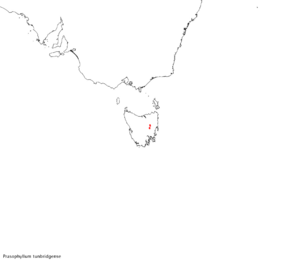Tunbridge leek orchid facts for kids
Quick facts for kids Tunbridge leek orchid |
|
|---|---|
| Conservation status | |
| Scientific classification |
Prasophyllum tunbridgense, also known as the Tunbridge leek orchid, is a special type of orchid. It grows only in Tasmania, which means it is endemic there. This plant has a single, bright green, tube-shaped leaf. It produces up to twenty-five flowers. These flowers are usually green to light greenish-brown. They have white petals and a large white labellum, which is a special lip-like part of the flower.
Contents
What Does the Tunbridge Leek Orchid Look Like?
The Tunbridge leek orchid is a perennial herb. This means it lives for more than two years and has soft stems, not woody ones. It grows from an underground tuber, which is like a small storage organ.
Leaves and Stems
Each plant has one bright green leaf. This leaf is shaped like a tube and can grow to be about 20 to 30 centimeters (8 to 12 inches) long. It is about 4 to 6 millimeters (0.16 to 0.24 inches) wide. The bottom part of the leaf often has a purplish color.
Flowers and Their Features
The orchid produces a flowering spike that holds ten to twenty-five flowers. This spike is about 6 to 9 centimeters (2.4 to 3.5 inches) long. The whole plant can reach a height of 30 to 40 centimeters (12 to 16 inches). The flowers themselves are about 7 to 9 millimeters (0.28 to 0.35 inches) wide.
Like other leek orchids, these flowers are upside down. This means their labellum (the lip) is above the column (the central part) instead of below it. The top sepal, called the dorsal sepal, is brownish-green with purple marks. It is about 9 to 12 millimeters (0.35 to 0.47 inches) long. The side sepals are about 7 to 8.5 millimeters (0.28 to 0.33 inches) long. The petals are narrow and white, about 7 to 8 millimeters (0.28 to 0.31 inches) long. They often have a purple line in the middle.
The labellum is white and about 8 millimeters (0.31 inches) long. It sharply bends upwards and slightly backwards in the middle. The edges of the upturned part are crinkled. There is also a greenish-yellow, fleshy, raised part called a callus in its center.
When Does it Flower?
The Tunbridge leek orchid usually flowers in October and early November. It tends to flower more after bushfires have occurred in the area.
How Was it Discovered and Named?
The Tunbridge leek orchid was officially described in 1998. It was named by David Jones, a botanist. He found a sample of the plant in a nature reserve near Tunbridge. The name tunbridgense refers to this place where it was first found.
Where Does the Tunbridge Leek Orchid Live?
This special orchid is only found in a few places in Tasmania. It grows in grasslands near the towns of Tunbridge and Campbell Town. There are only six known groups of these plants.
Why is This Orchid Endangered?
The Tunbridge leek orchid is a very rare plant. Scientists believe there are only about 140 of these orchids left. Because of its small numbers, it is listed as "Endangered." This means it is at a high risk of dying out.
Threats to Its Survival
The main dangers to this orchid are:
- Land clearing: When land is cleared for farming or building, the orchids lose their homes.
- Grazing by sheep: Sheep eat the plants, which stops them from growing and reproducing.
- Small population size: With so few plants, it's harder for them to recover from problems.
Protecting these orchids is very important to make sure they don't disappear forever.



